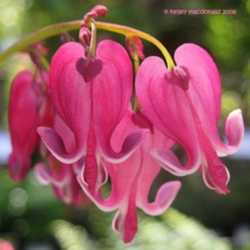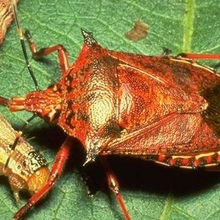(Editor's Note: This article was originally published on September 27, 2008. Your comments are welcome, but please be aware that authors of previously published articles may not be able to promptly respond to new questions or comments.)
Tulips are, without a doubt, one of the mainstay bulbs for the spring garden. Over 100 years of hybridizing has given rise to hundreds of hybrids, most which are far different from their more humble ancestors; in fact, we do not know with certainly, who the ancestors were! The numerous hybrids are now classified into specific groups; single early, single late, Darwin, triumph, double early, double late, viridiflora...and the list goes on. These hybrids are often short-lived in the garden but they are reasonably cheap to purchase, so can be treated like annuals if need be. The focus of this article will be the ‘botanical’ tulips; the wild species and selections from them. In the wild, there are some 100 or so species, native primarily to the eastern Mediterranean, Asia Minor and extended east into the Altai region. Most grow in a climate that is cool and wet in winter but baking dry and hot in summer. Such conditions are not easy to duplicate in most gardens, hence those that demand this summer baking, are quite rare in the trade. However, there are enough botanical types to keep most gardeners satisfied. While some of the available types still prefer the summer baking, they are so cheap that gardeners who live in cool, summer-wet climates (such as myself) can grow them as annuals. Thankfully a few are carefree and seem to thrive no matter where they are grown. As long as the soil is reasonably fertile and well-drained and they are planted in full sun, some of these ‘botanical’ tulips will perform admirably. Many of the popular ‘botanical’ tulips are shorter in stature than the classic tulips and often more long-lived. Several bloom before the main tulip season, while others are quite late. Some have very attractive foliage which may be wavy-edged, blue-grey or maroon-striped. In the garden, I plant them in groups of 5 or 7, usually in a rock garden setting or the front of the border.
Among the earliest tulip to bloom is Tulipa kaufmanniana, often called the water-lily tulip. The wild form is white to cream with reddish shading on the outer petals (botanically the sepals). Today, there are many selections and/or hybrids available (this species, T. greigii and T. fosteriana have been hybridized among each other). The wild T. kaufmanniana has plain green leaves so if pale red veins are seen, then it probably has some T. greigii genes. Most grow around 15-20 cm in height. Some of the more popular selections include ‘Ancilla’ (white, red flushed exterior), ‘Concerto’ (cream), ‘Corona’ (cream-yellow and red), ‘Fashion’ (orange-red), ‘Heart’s Delight’ (red and pink), ‘Johann Strauss’ (red and cream), ‘Shakespeare’ (red and orange), ‘Showwinner’ (red) and ‘Stresa’ (red and bright yellow).






Pictured above are T. kaufmanniana ( the species itself), 'Corona', 'Ancilla', 'Showwinner', 'Stresa' and 'Heart's Delight'
Tulipa greigii is unmistakable as the leaves are heavily striped in red. The flowers are also huge in relation to the size of the plant, which is usually a bit taller than T. kaufmanniana, at 20-30 cm. The wild T. greigii has vermillion-red flowers, but modern hybrids are mixtures of red, orange and yellow. Some of the available selections/hybrids are ‘Compostella’ (yellow, orange and red blend), ‘Cape Cod’ (yellow and red), ‘Chopin’ (red and cream), ‘Czar Peter’ (red and white), ‘Dreamboat’ (pink and yellow), ‘Oratorio (pink), ‘Pinocchio (red and white), ‘Red Riding Hood’ (red; most striking foliage) and ‘Toronto’ (multi-flowering with lipstick-pink blooms).





Pictured above are hybrids of T. greigii: 'Chopin', 'Cape Cod', 'Compostella', 'Toronto' and 'Red Riding Hood'
Fosteriana or Emperor tulips (T. fosteriana) are also quite popular and come closest to looking like the standard tulips except their flowers are more elongated. Their foliage is plain green and the plants reach 30-45 cm. The wild form is bright red but most of today’s selections are hybrids with some T. greigii or T. kaufmanniana genes. The most popular hybrids have the name ‘Emperor’ attached eg. ‘Red Emperor’(aka ‘Madame Lefeber’), ‘Pink Emperor’(aka ‘Solva’), ‘Orange Emperor’, ‘Golden Emperor’ and ‘White Emperor’ (aka ‘Purissima’). Other selections include ‘Candela’ (yellow), ‘Easter Moon’ (yellow with white variegated foliage), ‘Flaming Purissima’ (cream and pink blend), ‘Juan’ (orange with yellow base) and ‘Sweetheart’ (yellow with white edge). All three of the above tulips generally flower just before the standard tulips.




Some selections of T. fosteriana include 'Solva', 'Purimssima', 'Red Emperor' and 'Candela'
Next we come to the true species tulips. Some of these are easy to grow, others more challenging. Tulipa batalini is an easy, choice species which grows only 10 cm tall. The flowers are on the small side but still very attractive. The foliage is also small, narrow, blue to grey-green and often wavy edged. There are two main selections; ‘Red Gem (bright red) and ‘Bright Gem (yellow with orange flush). Tulipa dasystemon (aka T. tarda) is a prolific species that multiplies quickly by bulb-splitting and seed. It has yellow, star-shaped flowers with white tips. Each bulb can produce a cluster of 2-5 flowers. Plants grow about 10-15 cm in height. Tulipa turkestanica also has star-shaped flowers in clusters of up to 12! The blooms are white with a yellow base. Plants reach 20-25 cm with narrow, grey-green foliage. Tulipa praestans is another reliable species with wide, grey-green leaves and clusters of vibrant fluorescent orange flowers on 30 cm plants. There are several named selections including ‘Fusilier’ (bright orange-red), ‘Van Tubergen’s variety’ (bright red) and ‘Unicum’ (orange-red with striking white variegated leaves). There are two hybrid ‘botanical’ tulips on the market which have a strong influence from Tulipa hageri; ‘Little Princess’ (magenta-pink with blue center) and ‘Little Beauty’ (reddish-orange with blue center). Both of these reach about 15-20 cm and are among the last tulips to bloom.




Some reliable species are Tulipa batalinii 'Bright Gem', 'Red Gem', T. tarda and T. turkestanica





Among the selections of T. praestans are 'Fusilier', 'Van Tubergen's Variety' and 'Unicum'; hybrids derived from T. hageri include 'Little Beauty' and 'Little Princess'
The following tulip species are more challenging, requiring a good summer baking to perform well. Due to my growing conditions, I have to grow these as annuals. Some will come back for a few years, but for me, they gradually die off. Gardeners in the mid-west would probably have better luck. Tulipa bakeri produces a single, glossy, bright green leaf. The flower stems reach 15-20 cm topped by a single mauve-pink flower with a striking yellow center. ‘Lilac Wonder’ is the standard selection. Tulipa saxatilis is very similar but has more lilac-pink flowers. Tulipa clusiana is one of the taller species tulips (25-35 cm) with narrow, grey-green foliage and small flowers the shape of Fosteriana tulips. There are two main selections: ‘Cynthia’ (red and yellow) and ‘Peppermint Stick’ (red and white). Tulipa humilis is a striking species whose flowers are magenta with a bright yellow center. They grow 10-15 cm tall. There are several named selections including ‘Eastern Star’ (rose-pink), ‘Persian Pearl’ (magenta with silvery lilac outer petals) and ‘Violacea’ (purple). Tulipa linifolia has very narrow foliage on a 20-30 cm plant. The star-shaped flowers are red or yellow. Tulipa kolpakowskiana is a most charming species reaching just 10-15 cm. The flowers are mini yellow stars set atop narrow, blue-grey, wavy-edged leaves. Among the tallest species is T. marjolletii, with plants growing to 50 cm. The flowers are like a smaller version of the modern tulip. They are creamy-yellow with pinkish-red margins and flush. Tulipa acuminata is quite a bizarre species. Plants reach 30-45 cm and have yellow, red-tinted flowers whose petals are very narrow with long-pointed tips.




Among the selections of T. humilis are 'Eastern Star', 'Persian Pearl' and 'Violacea'; also pictured is T. bakeri 'Lilac Wonder'





More challenging species include T. kolpakowskiana, T. clusiana 'Peppermint Stick', T. clusiana 'Cynthia', T. marjolletii and T. acuminata (photo courtesy of TomH3787)
I have ordered some species from specialist bulb companies in Europe. Alas, these too seem to require a summer baking to thrive but so far, a few are still hanging on. Among these were T. vvedenski (bright red; the double ‘v’ is not a typo!), T. maximowiczii (bright red), T. biflora (star-shaped cream flowers) and T. sprengeri (bright red).


Available from specialty nurseries are T. vvedenski and T. maximowiczii
As can be seen, there are plenty of ‘botanical’ tulips out there to mix with your standards. While the plants are not so picturesque as modern tulips, they are still deserving of a place in our spring gardens.

















